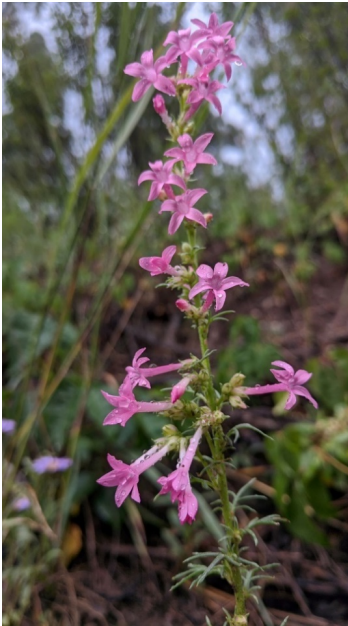Holy Ghost Ipomopsis – Conserving a Rare Spirit of the New Mexico Mountains
by Dan Hughes, March 2025
The southernmost range of the Rocky Mountains in New Mexico provides a stunning backdrop to the city of Santa Fe. Its peaks are a painting come to life: red-brown soil, dark pinyon green, and in fall the shock of yellow Aspens is followed by the soft white of winter snow. The ranges were named the Sangre de Cristo mountains – the Blood of Christ – for the pink-red hues they take on at sunset. Here at the Southwestern Branch of the Institute for Applied Ecology, based in Santa Fe, we often admire the mountain colors as we embark or return from our fieldwork missions throughout the state.
Rivers have carved many canyons in the Sangre de Cristos, and one of these canyons provides the sole habitat for a New Mexican plant species as beautiful as it is threatened. The Holy Ghost Ipomopsis (Ipomopsis sancti-spiritus) is only found in its eponymous Holy Ghost Canyon in the Santa Fe National Forest, north of the small town of Pecos. Tall and showy, in its deep-pink flowers the Holy Ghost Ipomopsis has managed to capture some of the spirit of a mountain sunset.

The species is a member of the Polemoniaceae, or the Phlox family, and its genus Ipomopsis contains 29 species. Many are wide ranging, capable of living in diverse habitats throughout Mexico and the American West. The Holy Ghost Ipomopsis is different. Not only is it endemic to the state of New Mexico, its natural range is restricted entirely to Holy Ghost Canyon, making it one of the most range-limited species in the country, with a population of less than 8,000 plants.
In many ways, this species is quite close in appearance to Ipomopsis aggregata, the skyrocket, found throughout the West from Mexico to Canada. But come flowering season, the most major difference is obvious: while the skyrocket has scarlet-red blooms, those of Holy Ghost Ipompsis are a rich, shocking, pink. This color variation has effects beyond the superficial. Pollinators often use color to navigate, and differences between plants can reduce cross-pollination and keep populations genetically separated.
Combined with its geographic separation, there is no doubt Holy Ghost Ipomopsis is its own species, requiring special attention to ensure its preservation.
Collecting Seeds for Genetic Preservation
In fall 2024, IAE was pleased to partner with federal agencies and community organizations like the the U.S. Forest Service, Albuquerque BioPark, and NAU Arboretum in the effort to conserve Holy Ghost Ipomopsis. In October and November, we gathered hundreds of viable seeds. In case anything happens to the wild population, these seeds will provide an invaluable resource for restoration.
Funding and logistical support was provided by the Center for Plant Conservation (CPC). CPC is a national-level nonprofit dedicated to the conservation of rare, threatened, and endangered North American plants. Last year, we were delighted to collect seeds from three additional species besides Holy Ghost Ipomopsis.

We ship our collections to both the CPC’s headquarters in San Diego and the National Laboratory for Genetic Resource Preservation in Fort Collins, CO. We loved working with the CPC, and hope to collect many more species in the fall of 2025!
Protecting Biodiversity for Future Generations
Gracing its mountain valley with an extraordinary beauty, the Holy Ghost Ipomopsis has lived up to its spiritual name. But an endangered plant is a responsibility as much as it is a blessing. Much of New Mexico’s biodiversity comes from rare and threatened species: these require constant monitoring to ensure that land use and climate change do not threaten their existence. By working with a diverse array of partners and landowners, the Institute for Applied Ecology can ensure the unique species that make our state the Land of Enchantment may be preserved for future generations.
